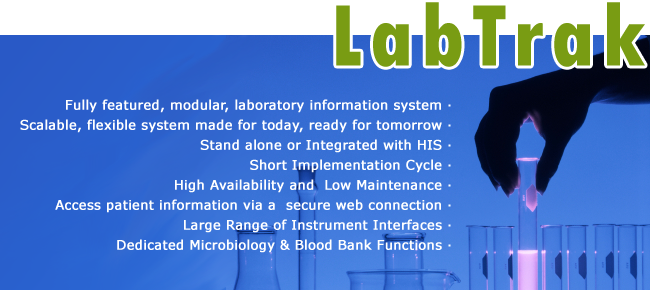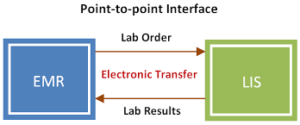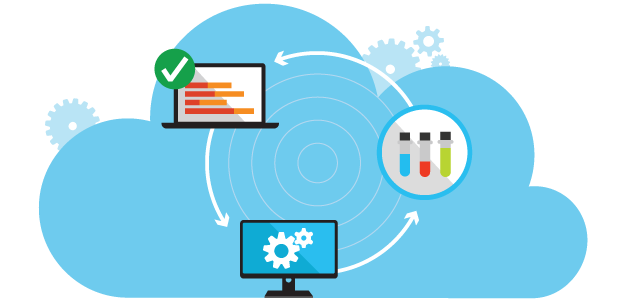Introducing the world’s first Laboratory Business Management System
Go Beyond the Limits of LIMS
InterSystems has raised the bar by introducing the world’s first Laboratory Business Management System (LBMS), a fully-unified module with TrakCare, which will help customers transform from a reactive testing and results service to a proactive healthcare partner.
To learn more about the shifting trends affecting laboratories, read the following articles:
- Genomics and its impact on information technology in the clinical laboratory
- Tips for thriving in the age of diversified laboratory testing
- Article: Laboratory Market Transformation Drives Systems Innovation
Further information:
TrakCare Lab meets all of the operational needs of the modern pathology laboratory. It is designed specifically to streamline the diverse activities of laboratories in the areas of:

It has been designed to integrate with a complete hospital management system, or to function as a self-contained, fully featured package for the modern dynamic pathology practice.
Each laboratory has individual requirements and workflows that need to be accommodated. For this reason, TrakCare Lab is written so that it provides maximum flexibility in regards to configuration. Just as no laboratory is equal, no Lab system is equal in its individual laboratory configuration. Thus meeting the needs of laboratories all over the world.
TrakCare Lab provides a comprehensive solution for the data management needs of any laboratory via:
- Customised patient entry screens per department or laboratory user site
- Automatic faxing or emailling of results, including details of patient’s history and medical condition, to referring doctors
- Remote system access
- Alerts based on conditions
- Integration with Microsoft Word
- Export of information to other systems
- Patient management
- Defined patient and data flow
- Unlimited capacity for clinical history details and comments
- Image scanning (e.g. request forms)
TrakCare Lab supports the needs of laboratory professionals to process and analyse results. It also provides caregivers access to those results in formats that they understand. Physicians have been able to use their mobile devices to access and review results in several hospitals.
By using a combination of dedicated modules, TrakCare Lab meets the needs of the modern day pathology laboratory by providing the tools to enter patient-testing episodes rapidly, efficiently and with the use of user-defined crosschecks, as accurately as possible.
TrakCare Lab provides this function to the laboratory via the user-definable patient entry module. The patient entry screen is tailored to suit the entire pathology firm, an individual laboratory and even a particular department. TrakCare Lab completely fulfills the requirements of the data entry department of the laboratory. Provided also are:
- Rapid entry of a patient’s episode testing details within the specimen reception department with the use of barcode readers.
- Scanning of request forms for instant viewing by laboratory staff. This facility allows laboratories to become ‘paperless’.
Over 300 of the most common and latest analyser interfaces are already available, offering uni- and bi-directional capabilities with barcode reader functionality and direct TCP/IP interface connections via dedicated instrument terminal servers, utilising the ASTM or supplier/analyzer-specific protocols.
Interfaces are provided for both uni- and bi-directional analyser interfaces, including barcode reading functionality. The results of patient tests can be exported directly from a laboratory instrument to TrakCare Lab. These results are then verified and released by a scientist so that a patient report is generated and the testing procedure is completed. Alternatively, patient results that are considered ‘normal’ can automatically verify and a patient report is generated. This is allows scientists to utilize their time more efficiently, only concentrating on abnormal testing results. The advantage that this facility provides is that results do not have to be printed from a machine and manually entered by a technician. This process would reveal two distinct disadvantages:
- It is labour intensive and time consuming to enter many results into TrakCare Lab manually.
- Transcription errors can result from keying in results, thus producing an incorrect result.
The user has the ability to view results that have been transmitted to TrakCare Lab by the individual instrument or by alternate instruments by any workstation in the laboratory without the need to be physically close to the analyzer.
A preview is available to see how the report will print and a cumulative view is also possible to view the test results of the patient compared to the results of previous testing. The test results of parameters that use numeric entry are also graphed to display a viewer-friendly indication of any changes in parameters of the particular test.

A number of modules facilitate manual entry such as

incorporates multiple tests with defined turnaround times. A dedicated worksheet module allows users to enter results on a screen that mirrors the layout of the printed worksheet, significantly improving the time of result entry for manual assays when interfacing is not available.
The entry of culture results is facilitated with the use of predefined antibiograms and the use of user-defined crosschecks. Interface to microbiology analyzers is also available.
monitors the status of specimens that have been sent to a reference laboratory for specialised testing.
After validation, the reports containing the results of patient testing for the clinician rely on the individual laboratory to define:
How the reports will be presented, that is, the format they will undertake when sent to the clinician
When. The doctor reports can be printed in real-time, i.e. when a patient’s testing is completed the report is automatically printed, or the reports can be scheduled so that they are held in a print queue and the user then commands the system to print all of the reports in a particular queue.
Where. Results can be automatically printed to the ordering location, they can be automatically faxed or emailed to the requesting doctor and they can be available for viewing (to registered users) from any workstation in a hospital or through secure internet access.
Some of the TrakCare Lab modules that can be used to address specific needs are illustrated below:
TrakCare Lab includes a significant number of reports that satisfy the requirements of even the most complex laboratory. In addition, TrakCare’s underlying technology is fully ODBC-compliant, allowing users to use third-party reporting tools such as Business Objects Crystal Reports to create custom reports on an ad-hoc basis. When TrakCare Lab is installed in a laboratory, there are a number of generic reports that are provided to the client. Upon implementing the product, these reports can be modified to suit the individual laboratories needs.
incorporates a fully integrated quality control module for manual assays and interfaced instruments, including Levy-Jennings and Youden Plot graphing capabilities, as well as inter- and intra-laboratory analyser quality control comparisons.
provides departmental control for registration of specimens, allowing automatic retrieval for inclusion in reports. Through this module users can allocate specimens, procedures, and stains to specimens, and enable the printing of specimen-specific labels for slides, blocks, and cassette writers, either in batch mode or on an ad-hoc basis.
includes a dedicated specimen storage module in TrakCare Lab. Configuration of storage locations, including building, refrigerators, and the individual storage containers, can be configured entirely by users, ensuring accurate identification and retrieval of stored samples for further testing.
For interfacing requirements to external systems, TrakCare Lab uses PIT, HL7, and/or UN/EDIFACT formats. TrakCare Lab has also been configured to interface with external systems using client-specific proprietary formats.


NHS Wales Informatics Service (NWIS) has selected InterSystems as its National Laboratory Information Management System (LIMS) partner. The Welsh Assembly Government funding of £12.1m will be used to implement a single instance of InterSystems TrakCare Lab.

